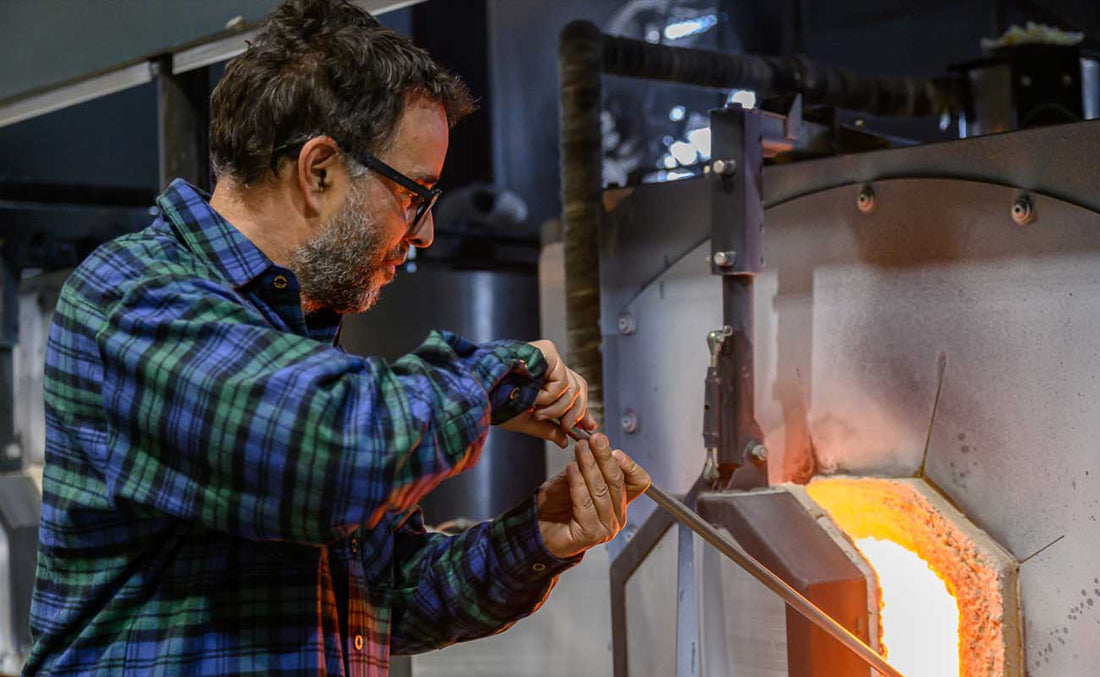
Meet the Maker: Rich Arentzen, Glass Maker
Share
“There's this kinetic beauty to glassblowing, there's this fluidity,” says Rich Arentzen, co-owner of Burlington’s AO Glass. “It's always moving and you are almost always working with other people in the same way that you would play a sport with someone or make music.”

AO Glass is tucked behind Speeder & Earl’s on Burlington’s Pine Street. That is, if you can “tuck” a huge, 10,000-square-foot wide-open factory space anywhere. It contains a beautiful, expansive shop full of gorgeous glass—everything from whiskey glasses to vases, from bowls to folklore-inspired ornaments near the entrance. Along the back wall several ovens glow, spewing out heat at 2000 degrees, while a few young glass blowers chat and turn out perfectly-shaped white glass balls.

“One thing that we really pride ourselves on,” Rich says, “is our sense of hospitality. We try to be very welcoming to people that come in. We often bring them right to the furnace, and maybe they've never stood that close to 2000 degrees—and literally people's mouths drop, and you can come in the most disgruntled person, but after that, there's this human connection of standing around a campfire, or watching the eclipse or something.”

AO Glass traces its roots through Connecticut (where Rich grew up) and New Hampshire (where his aunt and uncle modeled an idyllic artistic lifestyle) and Scandinavia (where Rich went in the mid-1990s to learn the craft and ended up meeting his wife and business partner, Tove Ohlander).
After getting married, the couple had a kid in Sweden, then moved to Norway, where they had a studio for about a decade. But, Rich recounts, “since I wasn't from Norway, it didn't really make sense for us to continue living there and raising kids. And we tried to live in Sweden, but there was already plenty of glass, so it was hard to make a living. But here, with 300 million Americans and kind of a robust collector market, we decided to move back. And we liked Burlington.
“Burlington is a bit of a cultural outpost,” he says, “where you have one foot in the dominant culture and then, in another sense, a very provincial area with its own little local culture… It was kind of a gentle place in America for [Tove] to land. It was very Scandinavian.”

They arrived back in the US in 2007, just in time for the recession, Rich laughs. “I worked at a bakery and I ended up getting the job because I said I was used to repetitive creative production and warm environments. And the manager gave me a hug and said, ‘Come with me. You're one of me.’”
AO got underway as a bit of a side hustle, then took off with a bang when The Smithsonian called one Monday (thanks to intercession by Bernie Sanders, who was trying to get the museum to carry more American-made goods) and ordered 500 glass polar bears and 500 glass snowmen.

After that, the business continued to grow “slowly for the next couple of years,” Rich says. “And then, around 2013, this was kind of the early makers movement trend… and one of the things that really caught on was this boutique lighting design, sculptural lighting.” AO got some contracts with influential New York designers and also companies like Hubbarton Forge, all of whom were aiming at high-end consumers and wanted to source American-made goods.

“So from 2013, right through Covid,” Rich says, “we just kept growing and we had a spike in growth during Covid as people were either moving or spending… Everyone thought it was going to last forever. So the companies overbought components from us.”

In 2022, when supply chain ills and interest rate hikes flipped the market, suddenly people stopped moving and hiring interior designers, and lighting companies had too much stock.
AO, which employs 15 people, Rich says, saw its sales dip to pre-Covid levels. They had to make some changes. “We took that opportunity to go back to our roots and start focusing on glass as an experience or as a more personal creation for making things that we would like to make. And also that resonated with gift-givers say, or people that came into the studio. So the experience here, seeing glass blowing, taking a class, getting something hand engraved, that really resonated with people. So we're focusing on that.

“Retail is changing,” Rich says. “A lot of people that used to have craft stores, they've kind of aged out, and young people aren't really starting it. So a place like this is almost like the new face of what retail is. There's an experiential component. Just trying to figure out how we monetize the experience in a way that still allows people to come in for free… And I think people generally, when they visit, maybe they want a whiskey glass, but often it's the story and the process and ‘Oh, I was here and now I understand this and this is part of our shared human history.’ So there is a value in that.”
There is indeed.

The Vermont Maker Project
Telling stories about makers across the state of Vermont. Photographed and written by StoryWorkz. Learn more at vermontmade.org.
Vermont makers wear Vermont Flannel.
